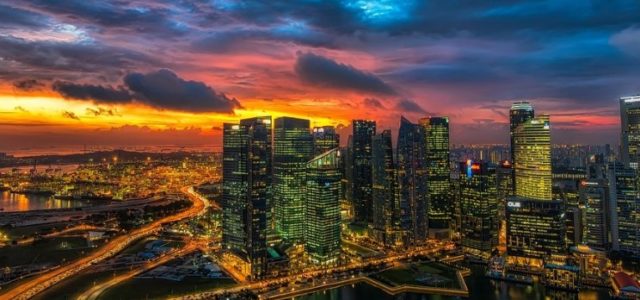During the seventh Smart City Expo World Congress (SCEWC), Digital Transformation Partner Huawei presented their latest predictions and achievements.
Smart Cities Trends
- A growing number of countries are incorporating smart cities into their national strategies and increasing investment towards implementation. According to a market survey released by MarketsandMarkets, the global market scale of smart cities is expected to increase from US$424.68 billion in 2017 to US$1201.69 billion by 2022, with a compound annual growth rate of 23.1%.
- According to Roland Berger’s Smart City Strategy Index in 2017, however, the “Smart City” has been an agenda item for many years now, but most cities lack a holistic and broad perspective leaving much room for improvement. In this report, 87 cities across the globe were examined looking at how they are embracing the smart revolution. Out of a maximum score of 100, the average city achieved 37. The Smart City strategy index is not determined by a city’s size or affluence, rather by its smart city ‘intelligence’.
- In the next decade, the global market capacity of the Smart City solution is expected to grow by 13% every year, from US$13 billion in 2017 to US$28 billion in 2023. Many enterprises will capitalize on the markets potential, working with governments to develop a comprehensive strategy, provide personalized solutions for different cities, and adopt more diversified modes based on actual conditions. The capability of a full connectivity serves as the foundation and engine of smart city development.
Background
According to a U.N. report, by 2030 two-thirds of the world’s population will be living in cities, the urban population in developing countries will double, and the area covered by cities could triple. The stable growth and increase in urbanization will place significant pressure on city infrastructures and services, forcing many cities to rethink how they will operate.
As city managers prepare for the series of rapid changes, many managers are responding to these challenges by developing Smart Cities. These cities are dynamic and constantly evolving by offering high quality services and efficient systems to meet the demands and expectations of their citizens, while ensuring sustainability for the future.
A Smart City is comprised of central ‘brain’ [the control center] and a series of ‘peripheral nerves’ [the network and sensors] that are constantly gathering and processing information from the city, its environment and infrastructure, all in real-time. For example, sensors can provide data on the transportation system performance enabling the brain to manage congestion, smooth demand and safely reduce delays for citizens.
Huawei, a leading global ICT company, has helped urban authorities across the world to create digitally-connected ecosystems that have transformed the way cities function — improving connectivity between people and things to generate innovation, economic growth and social progress. Through their leading new ICT, Huawei provides the city’s nervous system to deliver early warnings and provides unified coordination, cross-sector collaboration, and intelligent analysis for effective management of city services.
To date, Huawei’s Smart City solutions have been deployed in more than 200 cities across 40 countries.
Huawei Smart City Press Briefing
On Tuesday, November 14, as part of the Smart City Congress, Huawei hosted a press briefing, which included a Facebook Live session (I attended) for the Huawei Key Opinion Leaders.
In his opening remarks, Mr. Jo So, CTO, Industry Solutions, Marketing and Solution Sales, Enterprise Business, Huawei, introduced Huawei’s vision for success for Smart Cities.
The only way we (Huawei) can be successful is to be open and collaborative.
This collaboration focuses on the uniqueness of every city. As Mr. So stated “every city is facing different pains” and Huawei is open and prepared to work with each city to discover their unique pains, address and fix them by offering a valuable solution.
Addressing Concerns about Smart Cities
Data
Many of the questions during the press briefing involved the sensitive topic of Huawei’s access to city data. In response, Mr. Victor Yu, President, Industry Marketing and Solution Department, Enterprise Business Group, Huawei:
Huawei does not monetize data. We monetize technology and services.
Huawei views itself as an enabler of technology offering a win-win with all of its partners — channel, global, and service partners- not a data collector.
Safety
For every city, establishing and maintaining a Safe City is a top priority. Economic investment flows into areas that are safe. In fact, recently Huawei stated that it will be pushing the concept of safer cities through technology and IoT applications.
Huawei’s Ecosystem and Platform Underpins the Delivery of Future Smart Cities
According to Mr. So, Huawei is currently one of the only end-to-end providers for “cloud-pipe-device” smart cities solutions.
Smart City development is emerging as a major solution to tackle challenges relating to rapid urbanization in cities across the world. With 13 OpenLabs around the globe (19 expected by 2019), Huawei and its partners conduct joint research to build sustainable ecosystems and offer localized Smart City solutions. Through leading new ICT infrastructure, together with collaboration among its ecosystem of public and private sector partners, Huawei provides a Smart City nervous system that creates an intelligent and interconnected society to improve citizens’ quality of life.
Intelligent City vs Smart City
While Smart Cities is the accepted industry term, throughout the press briefing many of the panelists preferred Intelligent City. The nuance offers a more flexible approach, removing the focus on a tech-only solution.
Aspiring to Becoming Smart
As cities aspire to become Smart Cities, they confront a significant challenge — to create an effective operational system and environment in which the complex nervous system works seamlessly to constantly learn and enhance the city’s services.
The essence of a smart city is make everything sensible, connected and intelligent. Connected devices are the most basic level of intelligent cities, the next step is that they connect in a meaningful and valuable way to the citizens. During the press briefing, the panelists agreed that the biggest challenge, and opportunity, of setting up smart cities is the developing the “brain” or central nervous system. Since “the brain” aggregates data from different departments of the government and the city, “senses” issues, and then provides key data and information to all levels.
In recent conversations, Yan Lida, president of Huawei Enterprise Business Group stated that this central “brain” creates a seamless link between physical and digital worlds. By leveraging leading new IT such as cloud computing, IoT, and AI, Huawei is committed to creating a strong nervous system that powers smart cities.
Thankfully, Huawei is helping cities begin their transformative process into Smart Cities by delivering leading new ICT that enables a high-tech nervous system including an Intelligent Operations Center (IOC) serving as ‘the brain’ connecting the digital and physical worlds.
More specifically, Huawei provides wired and wireless broadband networks that enable ubiquitous broadband coverage supporting high-speed data, video, and voice services. Huawei also delivers an Internet of Things (IoT) platform comprising LiteOS, a secure, lightweight and intelligent OS, and Narrowband IoT (NB-IoT), a standards-based low power wide area (LPWA) technology developed to enable a wide range of new IoT devices and services.
Like the human nervous system, the IoT platform uses smart sensing to collect and consolidate information from across the city and connects to Huawei’s IOC that integrates, processes and analyzes vast amounts of disparate data in real-time, allowing appropriate actions to be taken.
The underlying infrastructure of the IOC is comprised of distributed cloud data centers and ubiquitous city networks that collect, integrate and share city information, enabling real-time visibility of the city. The IOC uses an Integrated Communications Platform (ICP) that enables intelligent collaboration across city functions and emergency dispatch of all services. By using Big Data, machine learning and Artificial Intelligence (AI) technologies, the IOC delivers valuable insights to facilitate city management and help city managers respond quickly to fast-changing city events.
Economic Outcome of Smart City
Underlying the entire Smart City concept is the economics behind the expansive endeavour. During the press briefing, a question was raised about how are Smart Cities a driver for economic growth? While the concept of Smart Cities is soon to become inevitable, the return on investment remains unclear. Are there considerations of ROI that surpass dollars and cents?
In many ways, the economics of a Smart Cities “come naturally,” according to Mr. So, when the city is positioned as a holistic commercial business model that is sustainable for future growth. When citizens feel safe, it is a direct driver of economic growth, which in turn boosts tourism and the overall GDP.
Yanbu: Building Saudi Arabia’s First Smart City
As urban authorities face increasing pressure to build Smart Cities that place citizens at the center, they are adopting Huawei’s Smart City solutions to help identify citizens’ needs and create services that enhance their lives.
One notable example can be seen in Yanbu, Saudi Arabia, a major industrial port city on the coast of the Red Sea. In Yanbu, Huawei is helping the Royal Commission (RC) to build country’s first Smart City, which will pave the way for Saudi Arabia’s country-wide Smart City transformation.
In Yanbu, Huawei used an optic fiber network covering the city’s residential housing, enterprises and key public areas, and deployed smart applications including: smart parking, smart heavy vehicle weighing, smart bins, smart energy management, smart streetlights, venue crowd analytics, and smart manhole covers. These applications have improved the efficiency of utility management and enhanced public safety and livability. For example, by turning Yanbu into a smart city, waste management efficiency has increased by 30%, energy costs for public lighting fell by 30%, and road maintenance costs were reduced by 20%. Huawei is also working with RC Yanbu to develop a city management platform to further improve municipal governance.
Driving Smart Tourism in Dunhuang, China
Building a Smart City can not only benefit citizens but can serve as a catalyst for economic growth. In a recent McKinsey report, by investing significant resources focused both on connecting and enhancing the productivity of countries along the new Silk Road, China is hoping to reap the benefits of cooperation, which can be shared and that the circle of friendship will be strengthened and expanded.
Take Dunhuang, China for example. As one of the ancient world’s most important intersections between East and West, Dunhuang is a popular city to visit on the Silk Road.

Photo by Chandler Chen on Unsplash
In Dunhuang’s desert areas, Smart Tourism has been developed to improve the quality of services during peak seasons and attract more tourists in off-peak seasons, all while promoting city governance and sustainable economic growth.
To achieve this, Huawei helped the Dunhuang Smart Tourism Company (DSTC) to build a central cloud center, linking the service systems of government departments to provide shared information that enables a quick and efficient response to city governance issues, public security, transportation, and city management emergencies. The project involved the development of a tourist traffic model for desert areas, through IoT, to improve city management, Silk Road tourism service quality and smart public services.
DSTC was a 2016 finalist for a ‘city award’ in the World Smart City Awards during last year’s Smart City Expo World Congress. The nomination recognized DSTC’s efforts and achievements in driving economic growth and enhancing people’s lives through pioneering systems and services.
Article by channel:
Everything you need to know about Digital Transformation
The best articles, news and events direct to your inbox







